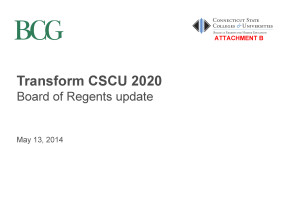The state university system that I am a part of has recently engaged a consultant to “assist with the development of a plan to transform the state university and community college system.” As a result, there are periodic Board of Regents updates that include publicly available presentations highlighting various activities. It is a fascinating opportunity to learn how transformation of higher education – via conventional methods – plays out in real time.
 I will periodically post Board of Regents presentations here, with brief critiques embedded in the .pdf file in RED (click on image to open file). My critiques will focus on the difference between conventional thinking and Lean thinking, as well as consultant’s role in higher education reform. I purposely use the term “reform” rather than “improvement.” (See my book, Lean University for a critique of consultant’s work in higher ed reform. Hint: It is both remarkably expensive and remarkably poor).
I will periodically post Board of Regents presentations here, with brief critiques embedded in the .pdf file in RED (click on image to open file). My critiques will focus on the difference between conventional thinking and Lean thinking, as well as consultant’s role in higher education reform. I purposely use the term “reform” rather than “improvement.” (See my book, Lean University for a critique of consultant’s work in higher ed reform. Hint: It is both remarkably expensive and remarkably poor).
For some time I have been advocating to leaders within my university of the need for improving teaching, and that this would have many positive benefits. And, it would be responsive to students’ and payer’s needs and serve the university’s and taxpayer’s interests as well. Yet, as far as I know, my message continues to be ignored by top leaders (you can’t be a prophet in your own land, I suppose). What could be some of the reasons?
- They don’t see teaching as a problem, presumably because people with PhDs are smart enough to do a good job.
- Teaching is judged to be good based on institutional data.
- They are unconvinced by my data and arguments (read here, here, and here).
- It is too difficult to acknowledge the reality that teaching is not that good, and they are at a loss for what to do about it due to various real and perceived constraints.
- Or, the above four items in combination or something else alltogether.
Being responsive to the core mission is “Student Learning and Success” begins with teaching. It requires administrators, staff, and faculty to look at teaching in ways that they have not looked at it before: to see problems and make improvements. Yet, there is a closed-mindedness, or at least an inability to look beyond one’s four walls – particularly among top administrators – to see practical alternatives. Inexpensive solutions to complex problems invariably lie with one’s own people. Leaders who do not understand that make a repetitive error that greatly benefits consultants. Leaders who don’t respect their people are a consultant’s best friend.
Despite the appearance of inclusiveness, there is a disrespect for faculty and staff that the consultant’s hiring makes clear. Top administrators signal: “We know the faculty and staff. They’ve got nothing to offer. We’re in charge and we’ll fix it.” The focus will be the budget, not administrative and academic process improvement. My old sensei referred to this as “money games,” meaning the appearance of improvement without any actual process improvement.
 Hierarchies normally result in views among leaders that are at odds with reality. The ideas of someone in a superior position are not automatically better than someone in a subordinate position. If fact, decision-making by superiors is usually tainted by untested beliefs and assumptions, illogical thinking, and decision-making traps, while decision-making at the lowest levels are often (but not always) more concerned about the well-being of the student. That is why in Lean management, leaders respect the people who do the work, they listen to them, and they participate with them side-by-side in process improvement.
Hierarchies normally result in views among leaders that are at odds with reality. The ideas of someone in a superior position are not automatically better than someone in a subordinate position. If fact, decision-making by superiors is usually tainted by untested beliefs and assumptions, illogical thinking, and decision-making traps, while decision-making at the lowest levels are often (but not always) more concerned about the well-being of the student. That is why in Lean management, leaders respect the people who do the work, they listen to them, and they participate with them side-by-side in process improvement.
